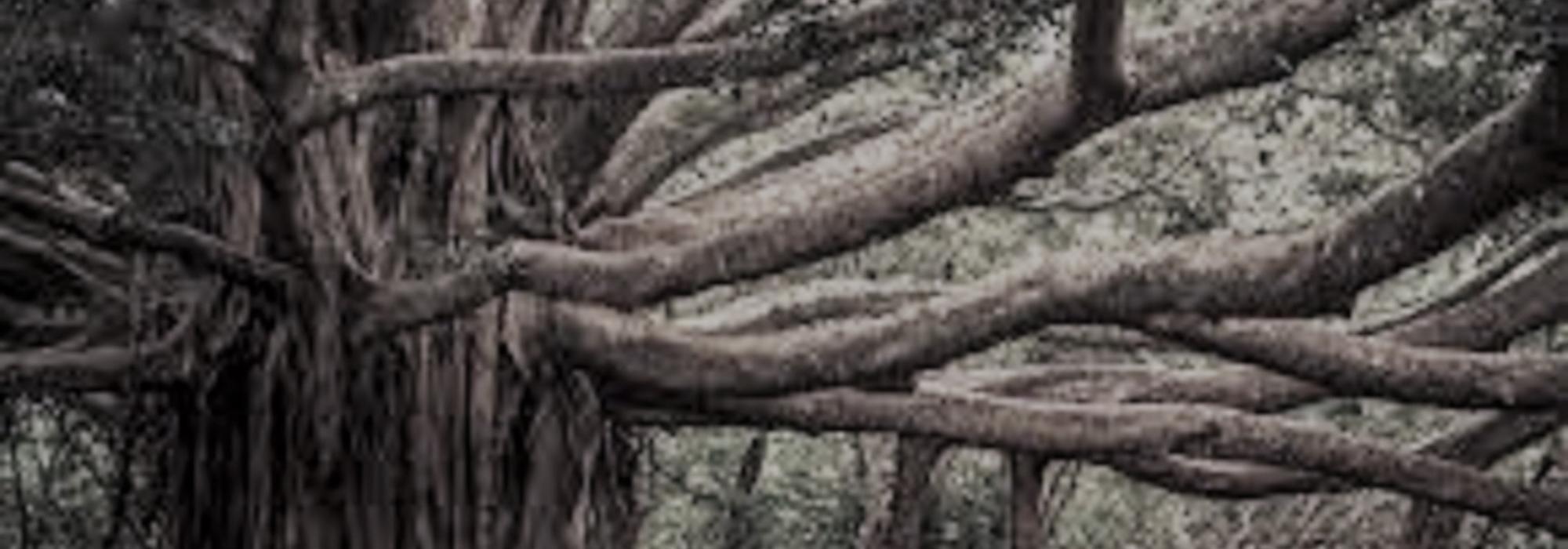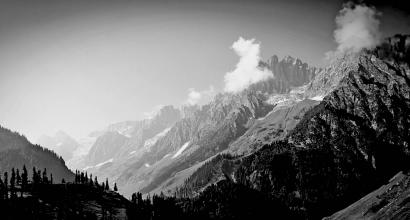Bhavabhūti epitomizes the vicitra-mārga that Kuntaka propounds.[1] A word that captures his use of language and delineation of emotions is fulness – fulness bordering on excess. He likes repetition and overemphasis. He has repeated several verses in his plays.[2] What is atyukti to most people is to him a nyūnokti. If modern formatting techniques were available back then, he would have made the most of various typefaces, type-sizes and such tools as bold, italics, underline, strikethrough and highlight.
Critics have largely been unfair to Bhavabhūti in counting his love of the excess as a literary blemish. Every poet has certain preferences that are moulded by his mind-set. [3] These preferences go on to shape his style. It is unreasonable to criticize a poet for having an unusual style. The proof of the pudding is in the eating. What matters is the effect he has achieved by employing that style. Has it aided him in the portrayal of various moods? How does it make him unique? What does it add to the existing corpus of literary nuance? These are the questions to ask. As an answer it is fair to say that Bhavabhūti’s style has worked in his favour. It has brought a new strength and sparkle to Sanskrit literature.
* * *
In Bhavabhūti, we see a passionate longing to achieve something unordinary, to scale great heights. His is a full-blooded attempt to get a full-orbed vision of ultimate verities in life and literature. He is rhapsodic but contemplative, flighty yet profound. He is constantly trying to outdo himself, as though to prove a point to someone. Going by G K Bhat’s conjecture that Bhavabhūti’s family was disapproving of his literary pursuits, we can guess that he tried hard to make it big and show his detractors what he is capable of. Lack of trust must have induced self-pity and made him think of himself as an enigma.
Bhavabhūti seeks to soar in the sky of serenity (śānta) but inadvertently drowns in the pool of pathos (karuṇa). The famous verse[4] that upholds karuṇa as the only rasa is a case in point: Śānta is the sole and supreme rasa, not karuṇa. But our poet thinks otherwise. His delineation of pathos—particularly in the Uttara-rāma-carita—scalds more than it soothes. In a sense, this reflects his fondness for self-pity. When he pictures the protagonist Rāma as maintaining a cheerful façade while boiling on the inside, he is unveiling a part of himself:
अनिर्भिन्नो गभीरत्वादन्तर्गूढघनव्यथः।
पुटपाकप्रतीकाशो रामस्य करुणो रसः॥(3.1)
Rāma’s anguish does not show because of his (its) profundity. It lies hidden deep within him and causes unspeakable pain, like a [pill] simmering [in a] closed pot.
Here are a few statements that give a flavour of pathos as Bhavabhūti conceives it:
जनस्थाने शून्ये विकलकरणैरार्यचरितै-
रपि ग्रावा रोदित्यपि दलति वज्रस्य हृदयम्॥ (1.28)
Rāma’s acts in the desolate Janasthāna, when he lost [Sītā and thereby] his senses, would make even a stone weep, would shatter even a diamond.
शैशवात्प्रभृति पोषितां प्रियां
सौहृदादपृथगाश्रयामिमाम्।
छद्मना परिददामि मृत्यवे
सौनिके गृहशकुन्तिकामिव॥ (1.45)
I have doted over Sītā from her childhood. Deep affection never allowed me to leave her side. And now, I am ready to defraud and deliver her over to death, like handing a pet bird to a butcher.
अपूर्वकर्मचण्डालमयि मुग्धे विमुञ्च माम्।
श्रितासि चन्दनभ्रान्त्या दुर्विपाकं विषद्रुमम्॥(1.46)
Innocent girl, leave me! I am a lowly man capable of appalling acts. You cling to a worthless, venomous tree mistaking it for sandalwood.
दुःखसंवेदनायैव रामे चैतन्यमाहितम्।
मर्मोपघातिभिः प्राणैर्वज्रकीलायितं हृदि॥(1.47)
I, Rāma, gained consciousness only to experience pain. Life, acting like a nail of diamond, punctures my heart.
रे हस्त दक्षिण मृतस्य शिशोर्द्विजस्य
जीवातवे विसृज शूद्रमुनौ कृपाणम्।
रामस्य बाहुरसि निर्भरगर्भखिन्न-
सीताविवासनपटोः करुणा कुतस्ते॥ (2.10)
O right hand, strike the śūdra monk with the sword so that the dead brāhmaṇa boy comes back to life. You are a limb of Rāma’s, who was capable of exiling Sītā when she was fatigued with a full foetus. Pity is unknown to you.
Bhavabhūti has used the Śikhariṇī metre with great felicity in delineating pathos. As G K Bhat observes, “Śikhariṇī has a natural lull and break and a slow movement; handled carefully it can suggest a slow-creeping joy or heart-moving pathos, both as deeply affecting emotions. Bhavabhūti does this so impressively that it has won him the highest praise from a later theoretician [Kṣemendra].”[5]
Despite his gruff exterior, Bhavabhūti was a romantic at heart. In Uttara-rāma-carita, he could not bring himself to end the story on an unhappy note. He devised an elaborate dramatic scheme to secure poetic justice for Sītā. At the root of this lies his inability to accept mankind’s fallibility and its unalterable predicament. Impelled by the same inability, he sought to soften the blame against Mantharā and Kaikeyī in Mahāvīra-carita. He pictured them as the unlucky victims of Mālyavān’s machinations. According to him, Śūrpaṇakhā possessed Mantharā and sowed the seed of discord in Kaikeyī’s mind. These, surely, are signs of a romantic mind.
* * *
In all likelihood Bhavabhūti was inspired by the Rāmāyaṇa to champion the cause of karuṇa. While most scholars agree that karuṇa is the predominant rasa in Vālmīki’s epic, some argue that it is a variety of vīra – dharma-vīra. Rāma is the embodiment of dharma. He is noble, magnanimous and valorous. Dharma-vīra, therefore, is central to the story that is based on him. Bhavabhūti sought to portray this dimension of the epic in his two plays: Mahāvīra-carita and Uttara-rāma-carita. The second can be thought of as a sequel to the first. Between these, he intended to depict all the significant aspects of the Rāmāyaṇa story: the events of Rāma’s youth leading to his marriage with Sītā in the former, and the story centred on Sītā’s banishment in the latter. Rāma is not seen prominently in Mahāvīra-carita. This makes the play’s name utterly ironic. To make up for this, Bhavabhūti attempts to show several facets of Rāma through various characters in Uttara-rāma-carita.
In attempting to present the entire Rāmāyaṇa story within a single frame, Bhavabhūti was probably inspired by the twelfth canto of Kālidāsa’s Raghuvamśa. He was also inspired by the kavi-kula-guru in coming up with the picture-gallery scene in the first act of Uttara-rāma-carita. Bhavabhūti has used this small clue given by Kālidāsa to great literary effect – to link the earlier life of Rāma to his later life, to highlight Rāma’s love for Sītā, to narrate the vagaries that the couple went through and finally to foreshadow the unfortunate turn of events that will befall them soon.
Kālidāsa’s influence on Bhavabhūti is also seen in Mālatī-mādhava. Kāmandakī, who plays a pivotal role in bringing together Mālatī and Mādhava, is modelled after Parivrājikā who features in Mālavikāgnimitra. Mādhava’s appeal to the cloud (9.25, 26) recalls Yakṣa’s words in Meghadūta. Bhavabhūti has used the same metre—Mandākrāntā—as Kālidāsa. R D Karmarkar has given an exhaustive list of such instances in the play.[6] As a contrast, Bhavabhūti rarely employs the Āryā metre, which Kālidāsa uses frequently in his plays. (Uttara-rāma-carita has only two of these.) Āryā is a melodious metre that can be set to tune easily. Bhavabhūti avoids it probably because he is a serious-minded poet who mainly intends to portray intense situations.
Bhavabhūti had deep respect for Ādikavi Vālmīki and his composition. Towards the end of Uttara-rāma-carita, he describes Rāmāyaṇa in this manner:
पाप्मभ्यश्च पुनाति वर्धयति च श्रेयांसि सेयं कथा
मङ्गल्या च मनोहरा च जगतो मातेव गङ्गेव च॥(6.20)
It is a story that removes evil and purifies us. It amplifies spiritual blessings. Like the mother of the world and the river Gaṅgā, it is at once auspicious and heart-warming.
His portrayal of Vālmīki as a playwright in the seventh act of Uttara-rāma-carita indicates his respect for his chosen craft and the reverence he had for his literary forebear. He brings in certain details that attest to his mastery over the Rāmāyaṇa. For instance, he refers to a tree by name Śyāma on the banks of Yamunā.[7] It serves as a beautiful reminder to the time that Rāma, Sītā and Lakṣmaṇa spent together in the forest. The time had its troubles; but it helped preserve memories that evoked relish in retrospect. In a flight of fabulous inspiration, he makes Lava refer to Rāma taking three steps back while fighting fourteen thousand rākṣasas headed by Khara.[8] When an entire army swooped down on Rāma all at once, he obviously had to take a few steps back to secure an optimum striking distance for his arrows. In the first act of Mālatī-mādhava, Bhavabhūti uses an idea similar to the famous verse in the Rāmāyaṇa where Rāma beseeches the wind to blow from the place where Sītā is, so that he gets to feel her tender touch.[9]
[1] Ref: Vakroktijīvita, 1.34–43
[2] For a comprehensive list of repetitions, see: Mahā-vīra-carita (Ed. Todar Mall), pp. xl–xliii (Introduction)
[3] कविस्वभावभेदनिबन्धनत्वेन काव्यप्रस्थानभेदः समञ्जसतां गाहते॥ (वक्रोक्तिजीवितम्, १.२४ वृत्तिः)
[4] Uttara-rāma-carita, 3.47
[5] Bhavabhūti, p. 62. Ref: Kṣemendra’s praise in Suvṛtta-tilaka:
भवभूतेः शिखरिणी निरर्गलतरङ्गिणी।
रुचिरा घनसन्दर्भे या मयूरीव नृत्यति॥ (३.३३)
[6] Mālatī-mādhava of Bhavabhūti, pp. xvii–xviii (Introduction)
[7] अयमसौ भरद्वाजावेदितश्चित्रकूटयायिनि वर्त्मनि वनस्पतिः कालिन्दीतटे वटः श्यामो नाम॥(उत्तररामचरितम्, १.२३ गद्यम्)
[8] यानि त्रीण्यकुतोभयान्यपि पदान्यासन् खरायोधने॥ (उत्तररामचरितम्, ५.३५)
[9] उन्मीलन्मुकुलकरालकुन्दकोश-
प्रश्च्योतद्घनमकरन्दगन्धबन्धो।
तामीषत्प्रचलविलोचनां नताङ्गी-
मालिङ्गन्पवन मम स्पृशाङ्गमङ्गम्॥ (मालतीमाधवम्, १.३८)
I owe an immense debt of gratitude to Śatāvadhānī R Ganesh. Apart from providing incredible insights into the works and personality of Bhavabhūti, he handheld me throughout this essay. I extend my heartfelt thanks to Prof. L V Shantakumari, G S Raghavendra, Sandeep Balakrishna and Hari Ravikumar for their valuable inputs. I am indebted to several scholars from whose valuable works on Bhavabhūti I have benefited immensely. Of them, I must name V V Mirashi and G K Bhat. While Mirashi’s work is instructive and comprehensive, Bhat’s book is insightful and eminently readable.
To be continued.










































